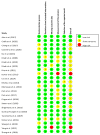Neurostimulation in People with Oropharyngeal Dysphagia: A Systematic Review and Meta-Analysis of Randomised Controlled Trials-Part II: Brain Neurostimulation
- PMID: 35207265
- PMCID: PMC8878820
- DOI: 10.3390/jcm11040993
Neurostimulation in People with Oropharyngeal Dysphagia: A Systematic Review and Meta-Analysis of Randomised Controlled Trials-Part II: Brain Neurostimulation
Abstract
Objective. To assess the effects of brain neurostimulation (i.e., repetitive transcranial magnetic stimulation [rTMS] and transcranial direct current stimulation [tDCS]) in people with oropharyngeal dysphagia (OD). Methods. Systematic literature searches were conducted in four electronic databases (CINAHL, Embase, PsycINFO, and PubMed) to retrieve randomised controlled trials (RCTs) only. Using the Revised Cochrane risk-of-bias tool for randomised trials (RoB 2), the methodological quality of included studies was evaluated, after which meta-analysis was conducted using a random-effects model. Results. In total, 24 studies reporting on brain neurostimulation were included: 11 studies on rTMS, 9 studies on tDCS, and 4 studies on combined neurostimulation interventions. Overall, within-group meta-analysis and between-group analysis for rTMS identified significant large and small effects in favour of stimulation, respectively. For tDCS, overall within-group analysis and between-group analysis identified significant large and moderate effects in favour of stimulation, respectively. Conclusion. Both rTMS and tDCS show promising effects in people with oropharyngeal dysphagia. However, comparisons between studies were challenging due to high heterogeneity in stimulation protocols and experimental parameters, potential moderators, and inconsistent methodological reporting. Generalisations of meta-analyses need to be interpreted with care. Future research should include large RCTs using standard protocols and reporting guidelines as achieved by international consensus.
Keywords: RCT; deglutition; intervention; rTMS; repetitive transcranial magnetic stimulation; swallowing disorders; tDCS; transcranial direct current stimulation.
Conflict of interest statement
The authors declare no conflict of interest.
Figures







References
-
- Baijens L.W., Clave P., Cras P., Ekberg O., Forster A., Kolb G.F., Leners J.C., Masiero S., Mateos-Nozal J., Ortego O., et al. European Society for Swallowing Disorders—European Union Geriatric Medicine Society white paper: Oropharyngeal dysphagia as a geriatric syndrome. Clin. Interv. Aging. 2016;11:1403–1428. doi: 10.2147/CIA.S107750. - DOI - PMC - PubMed
-
- Ciarán K., Regan R., Balding L., Higgins S., O’Leary N., Kelleher F., McDermott R., Armstrong J., Mihai A., Tiernan E., et al. Dysphagia prevalence and predictors in cancers outside the head, neck, and upper gastrointestinal tract. J. Pain Symptom Manag. 2019;58:949–958.e942. - PubMed
Publication types
LinkOut - more resources
Full Text Sources

